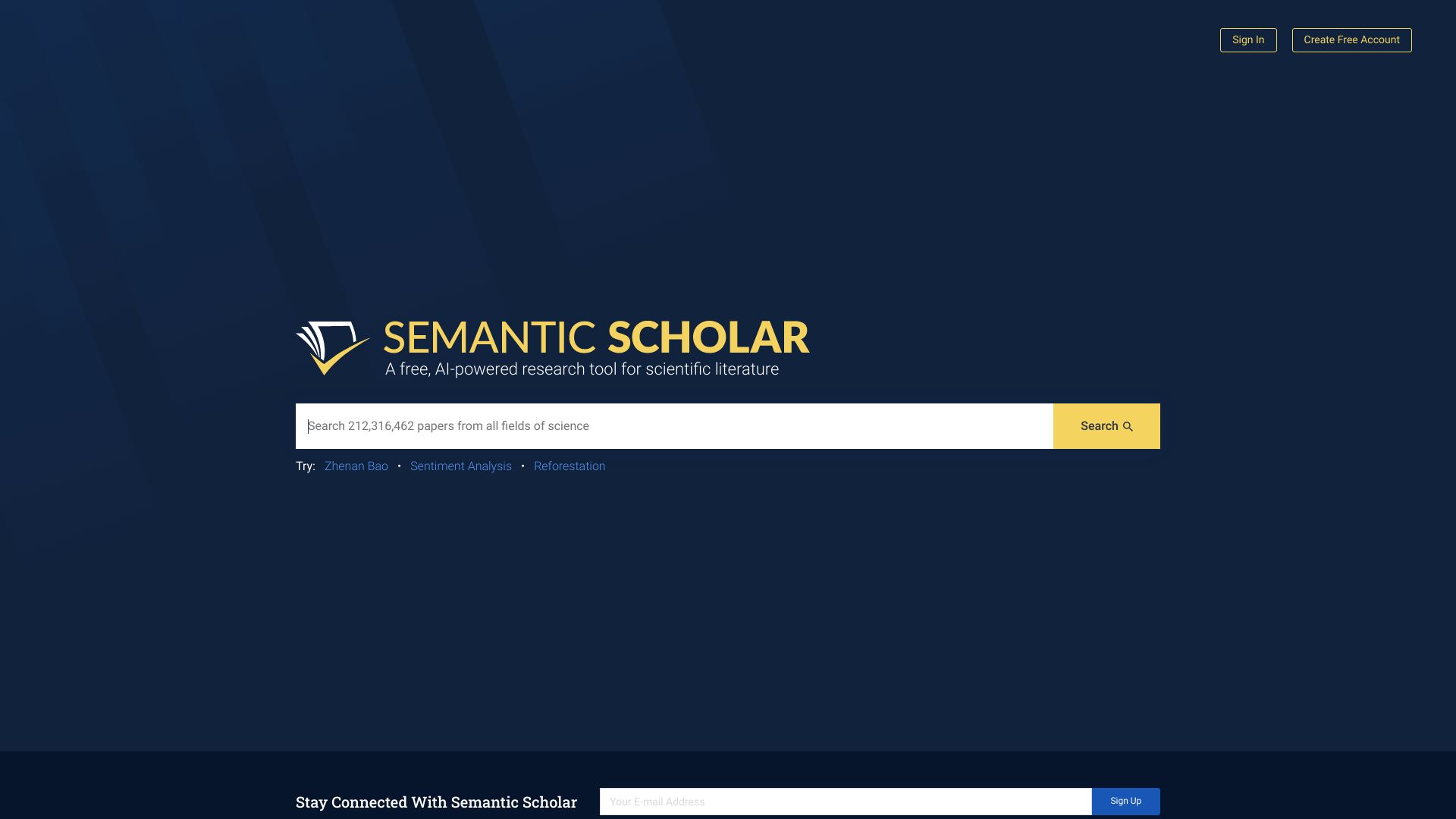
Semantic Scholar
Open Website-
Tool Introduction:Semantic Scholar: free AI research search that grasps paper meaning.
-
Inclusion Date:Oct 21, 2025
-
Social Media & Email:
Tool Information
What is Semantic Scholar AI
Semantic Scholar AI is a free, AI-powered research discovery platform from the Allen Institute for AI (AI2). It understands the semantics of scientific literature to surface relevant papers, map citation networks, and generate concise summaries. With intelligent search, topic filters, author and venue profiles, and open resources like APIs and datasets, it helps scholars and R&D teams navigate vast corpora, monitor new findings, and build evidence-based insights—reducing time spent on literature review while improving recall, precision, and transparency.
Semantic Scholar AI Main Features
- Semantic search and ranking: AI-driven relevance that goes beyond keywords to understand concepts and context in scientific papers.
- AI-powered summaries (TLDR): Concise, automatically generated highlights to quickly grasp a paper’s key contributions.
- Citation graph and influence: View citations, references, and influential citations to assess impact and trace prior art.
- Rich filtering and facets: Narrow results by field of study, year, venue, author, and more to refine literature reviews.
- Author and venue profiles: Disambiguated author pages, co-authorship networks, and venue information for credibility checks.
- Recommendations and alerts: Personalized paper recommendations and email alerts to track new research in your topics.
- Libraries and citations: Save papers to collections and export citations in common formats for reference managers.
- PDF access and reading: When available, open access links and an integrated PDF view streamline reading workflows.
- Open resources: Public APIs and research datasets support programmatic discovery and large-scale analysis.
Who Is Semantic Scholar AI For
Semantic Scholar AI suits academic researchers, graduate students, and librarians conducting systematic literature reviews; data scientists and engineers building research pipelines; clinical and biotech teams scanning biomedical evidence; R&D and product leaders monitoring prior art; and policy analysts or educators synthesizing peer-reviewed findings for decision-making and instruction.
How to Use Semantic Scholar AI
- Enter a query using keywords, problem statements, or author/venue names in the search bar.
- Apply filters (field, year, venue, author) and sort options to refine relevant scientific literature.
- Open a paper page to read the abstract, TLDR summary, references, citations, and related work.
- Follow citation chains to trace foundational studies and map the surrounding research landscape.
- Use Save or Collections to organize key papers for your project or systematic review.
- Export citations in your preferred format and add them to your reference manager.
- Set up recommendations or alerts to stay updated on new publications matching your interests.
- Optionally, leverage the API or datasets to integrate discovery into custom tools or analyses.
Semantic Scholar AI Industry Use Cases
Universities use Semantic Scholar AI to accelerate thesis framing and comprehensive literature reviews. Biotech and healthcare teams scan biomedical papers to identify targets, methods, and safety signals. Technology firms track state-of-the-art algorithms and benchmark datasets across AI, ML, and software engineering. Government and NGOs synthesize evidence on climate, education, or public health for policy briefs and program evaluation.
Semantic Scholar AI Pricing
Semantic Scholar AI is free to use. Open resources such as APIs and datasets are available under specific terms and usage limits; consult the official documentation for eligibility, licensing, and rate-limit details.
Semantic Scholar AI Pros and Cons
Pros:
- Free, AI-driven semantic search that improves relevance beyond keyword matching.
- Concise TLDR summaries speed up triage and screening.
- Transparent citation networks support impact assessment and prior art discovery.
- Robust filters, author profiles, and venue data enhance precision.
- Recommendations, alerts, and libraries streamline ongoing research workflows.
- APIs and datasets enable programmatic and large-scale research.
Cons:
- Coverage and metadata quality can vary by discipline and publication venue.
- Not all papers have accessible PDFs; full text may require publisher access.
- AI-generated summaries may miss nuances and should be verified against the paper.
- Occasional author disambiguation or citation errors may occur.
- APIs and datasets may have rate limits or licensing constraints.
Semantic Scholar AI FAQs
-
Does Semantic Scholar AI cover my field?
It indexes a wide range of disciplines across computer science, biomedical research, and many other fields, though coverage varies by area and venue.
-
How is it different from Google Scholar?
Semantic Scholar emphasizes semantic understanding, TLDR summaries, and a transparent citation graph, alongside open APIs and datasets.
-
Can I export citations?
Yes. You can export citations in common formats for use with reference managers.
-
Are there alerts for new papers?
Yes. You can enable recommendations and email alerts to track new publications matching your interests.
-
Does it include preprints?
Semantic Scholar AI includes many preprints from major repositories alongside peer-reviewed articles, depending on availability.
-
Is it free to use?
Yes. The platform is free, and additional resources like APIs and datasets are available under specific terms.
